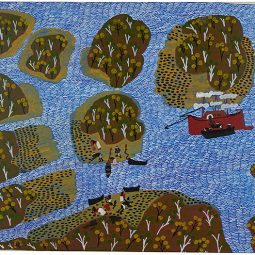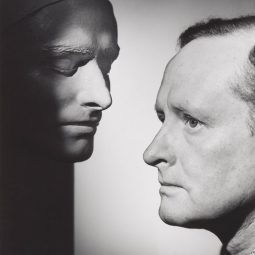“. . . the intertwinement between humanness and machines.”
In an energetic activation of the Museum of Contemporary Art Australia (MCA), Sydney, Primavera 2025: Young Australian Artists delves into reviewing, expanding, and broadening the audience’s world view. Curated by Tim Riley Walsh, Assistant Curator at the MCA Australia, the works by five artists under thirty-five – Francis Carmody, Alexandra Peters, Augusta Vinall Richardson, Keemon Williams, and Emmaline Zanelli – explore our current rapid technological advancements.
“There are moments of really profound convergence happening right now between technology, AI and humanity,” says Walsh. “Ideas I have been discussing with the artists as ways to describe this moment have been ‘technical culture’, which comes from the thought of Gilbert Simondon, what I have been calling ‘industrial abstraction’.”
And so, through the lens of ‘industrial abstraction’, Primavera 2025 investigates the intertwinement between humanness and machines. How a sense of displacement of physical interconnectedness translates into art. And as a result, how can it invite a deconstruction and deeper methodology on originality in these times?
“Over many studio visits, I was really struck by the integration of digital processes in the creation of physical forms,” says Walsh. “[This was] reflected in Francis’ and Keemon’s presentations, especially, an emphasis on the handmade and analogue processes, including steelwork like in Augusta’s sculptures and printmaking, expanded painting in Alexandra’s, and new forms of collaborative making, such as Emmaline’s centring of young adults’ expression and agency.”

Alexandra Peters, installation view, Future Remains: The 2024 Macfarlane Commissions, Australian Centre for Contemporary Art,
Naarm/Melbourne, 2024
Photograph: Andrew Curtis
© the artist
Courtesy the artist and Museum of Contemporary Art Australia
Naarm/Melbourne-based Augusta Vinall Richardson’s soft and moving geometric sculptures, made of steel, offer a juxtaposition of materiality with the lightness of touch. “Augusta always is reasserting her hand in the forms she makes – she’s challenging this sense of impersonal production and metal as this rigid, immovable system,” says Walsh. Also Naarm/Melbourne-based, and moving through an installation of printmaking and sculpture, Alexandra Peters connects the artist’s hand to the mechanics of reproduction, which Walsh shares is “submerged within images, signs and symbols. It turns its gaze onto reproduction as a subject in itself.”
Continuing these narratives, Naarm/Melbourne-based Francis Carmody employs experimental approaches to sculptural installations to explore historical and natural phenomena through a curiosity of materials. “As an audience member, you’re invited to follow him down the rabbit hole if you want, follow his mind and investigation, or simply revel in the material quality and impact of his forms,” Walsh continues.

Francis Carmody, Black Swan Event: Incubating (detail), 2024, plaster, horsehair, polymer paint, nylon, 60 × 60 × 30cm
Photograph: Christian Capurro
© the artist
Courtesy the artist and Museum of Contemporary Art Australia
Likewise, Tarndanya/Adelaide-based Emmaline Zanelli’s video and installation works stem from her time with young adults growing up near the Olympic Dam mine in regional South Australia, working in part-collaboration for a “fantastical journey into the mine.” Through a DnD game and an interconnected pet cage installation, Walsh reveals, “In the dark, it is filled with LED lights and twinkles like the mine at night, with its tunnels and cages echoing perhaps the underground realm that the kids explore.”

Emmaline Zanelli, I take care of what’s mine (still), 2023–24, two-channel video, sound, 25:47 minutes
Commissioned by Adelaide Film Festival X UniSA Samstag Museum of Art EXPAND Lab, Supported by Creative Australia
© the artist
Courtesy the artist and Museum of Contemporary Art Australia
In Kuku Yalanji, Koa, Meriam, and South Sea Islander artist Keemon Williams’ fabricated artwork, he builds on the stereotypes of the centring of First Nations culture in the Australian tourist industry. “There is a real cutting commentary here on the extraction by non-Indigenous people and non-Indigenous led companies within this market,” says Walsh. “But also, an important reflection on the demands placed on creative practitioners, especially First Nations artists.”

Keemon Williams, Business is Boomin’, 2021, porcelain, underglaze, glaze, epoxy, 5.5 × 4.5cm
Photograph: Kyle Weise
© the artist
Courtesy the artist and Museum of Contemporary Art Australia
As an immersive and cocooning three-dimensional exhibition, Walsh’s Primavera 2025 connects audiences to the pull and aura of viewing artworks in person. “I hope it reflects that we’re moving away from the cold, impersonal art of recent decades,” he concludes. “Some of the subject matter might be familiar – extraction, capital, industry – but my belief is that these artists and artworks are saying very insightful things about these topics in refreshing and challenging ways.”
Emma-Kate Wilson is an art and design writer and editor based on Gumbaynggirr Country (Bellingen, New South Wales).
Museum of Contemporary Art Australia
5 September 2025 to 8 March 2026
Sydney

